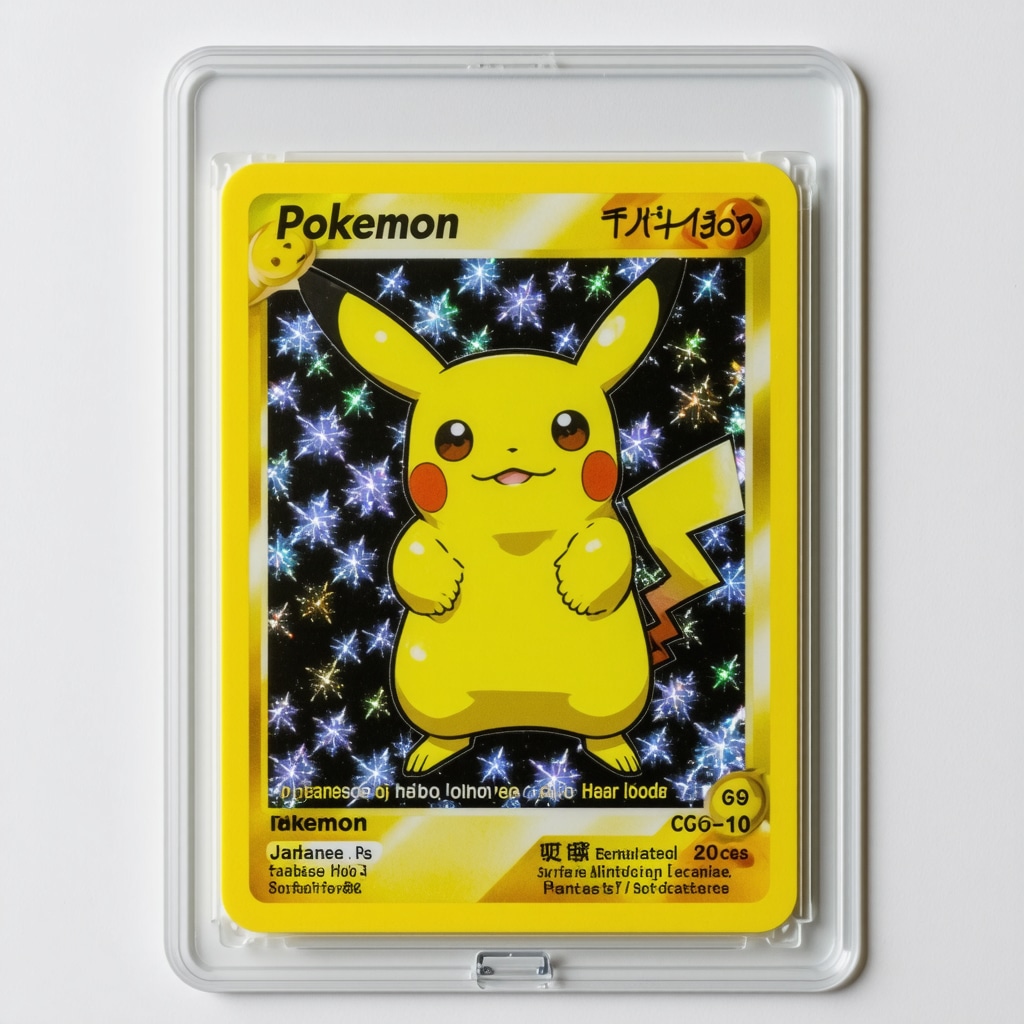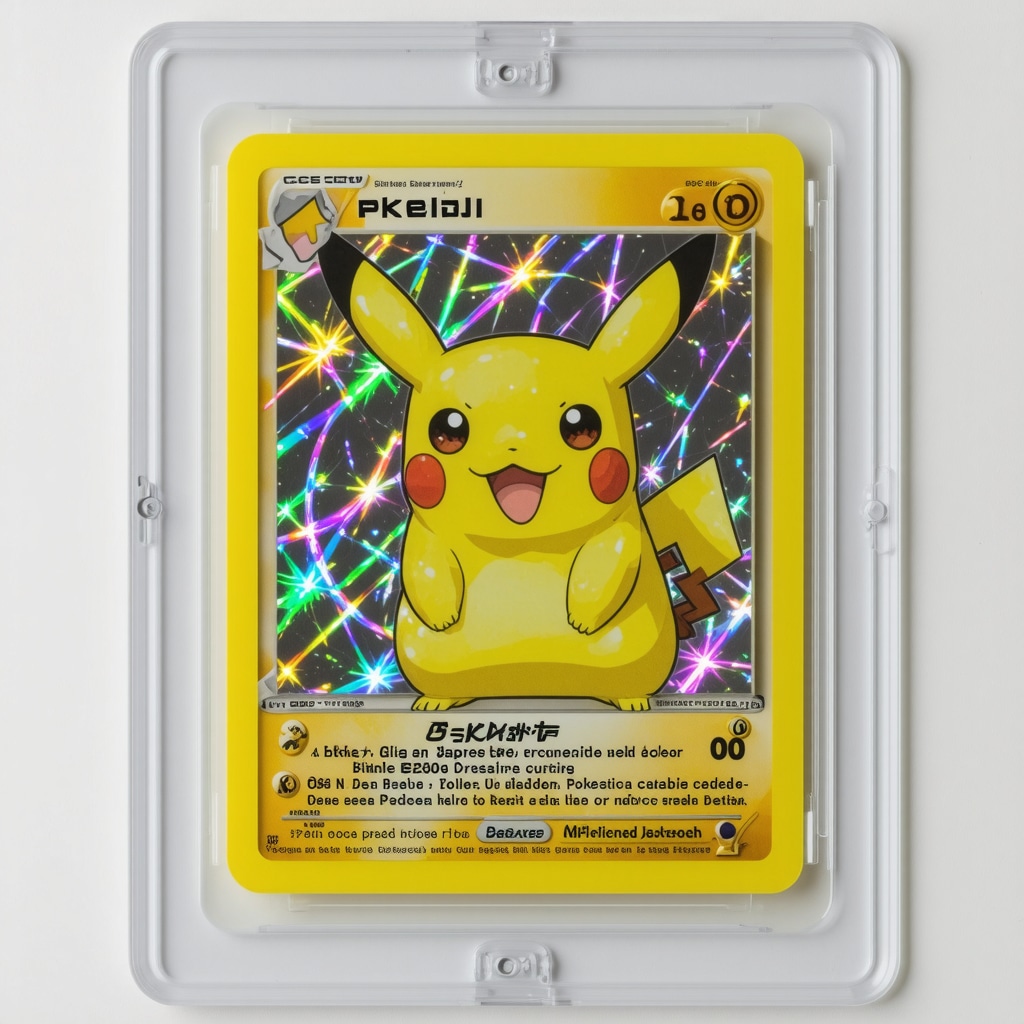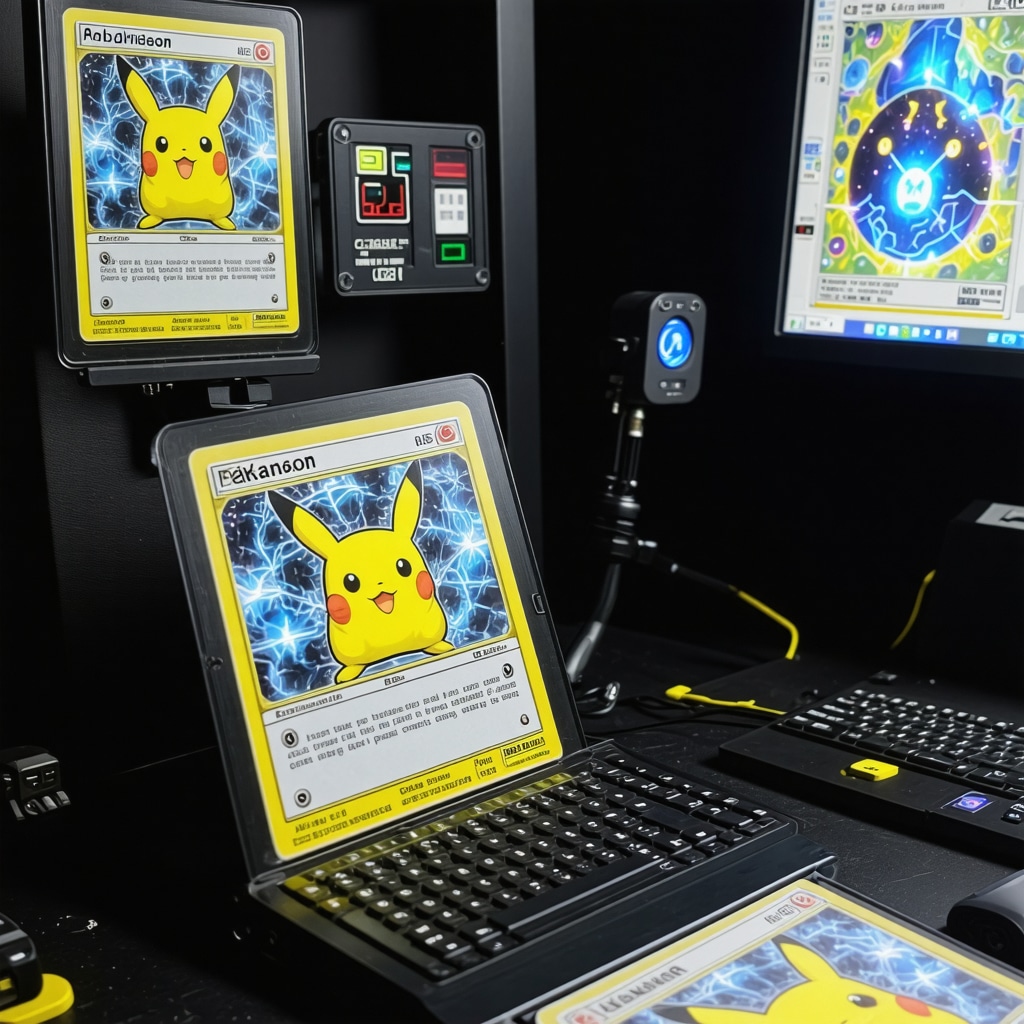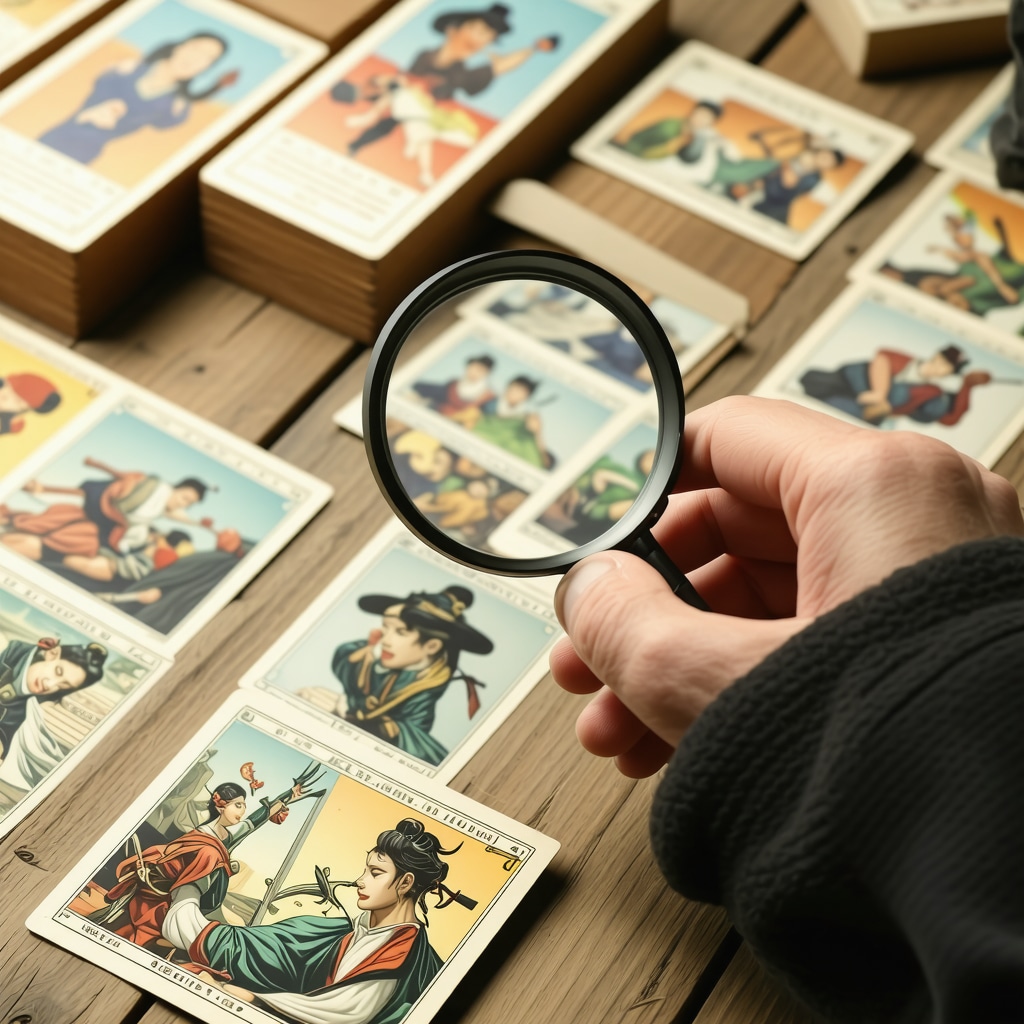Unlocking the Secrets: What Makes CGC 10 Japanese Vintage & Holo Rares Truly Rare?
In the intricate world of Pokémon card collecting, identifying rare CGC 10 Japanese vintage and holo rares quickly can be a game-changer for enthusiasts and investors alike. These cards, known for their impeccable condition graded by CGC, embody not only nostalgic value but also phenomenal investment potential. Yet, the challenge lies in distinguishing these high-grade treasures amidst a sea of look-alikes and counterfeit copies.
Understanding the rarity of CGC 10 Japanese cards goes beyond just the grade; it involves a keen eye for subtle details that only experienced collectors notice. For example, authentic Japanese vintage holo rares often feature distinctive holofoil patterns, precise coloration, and unique printing nuances that differ from English versions. The CGC grading process scrutinizes centering, surface gloss, edges, and corners, demanding near-perfect standards for a 10 grade, making these cards a rare find.
Rapid Recognition: Key Visual Cues to Spot CGC 10 Japanese Vintage & Holo Rares
Speed in identification is crucial, especially at card shows, auctions, or online marketplaces where rare cards are snapped up quickly. Start by examining the card’s holofoil texture — genuine vintage Japanese holo rares exhibit a delicate, often intricate, sheen that’s difficult to replicate. Additionally, the card’s edges and corners should be razor-sharp and free of any whitening or damage, as CGC 10 requires pristine condition.
Another practical tip is to verify the card’s back, where authentic Japanese cards have specific print clarity and font styles distinct from counterfeit cards. Experienced collectors often keep a reference library or digital catalog of verified CGC 10 Japanese vintage holo rares for side-by-side comparison, accelerating identification during fast-paced buying opportunities.
How Can You Authenticate CGC 10 Japanese Vintage & Holo Rares Quickly Without Expert Equipment?
While professional grading machines are the gold standard, collectors can perform several rapid authenticity checks. One effective method is using a strong light source to inspect holofoil patterns — real holo rares shimmer uniformly with no pixelation or distortion. Additionally, using a loupe or magnifying glass reveals printing details such as dot patterns and stroke precision that counterfeiters often miss.
Also, cross-referencing the card’s serial number or set symbol with official databases or trusted collector communities can validate its legitimacy. Websites like Pristine Pokemon Cards offer comprehensive guides that assist collectors in understanding CGC grading standards and quick authentication tips.
Expert Strategies: Leveraging Proven Tactics to Identify and Secure Rare Finds Faster
Veteran collectors recommend cultivating relationships with reputable dealers and participating in specialized forums focused on Japanese vintage holo rares. These networks often provide early alerts on authentic CGC 10 cards entering the market. Additionally, mastering knowledge of popular rare sets and specific card traits — such as the coveted Japanese Charizard holo rares — sharpens your ability to spot valuable cards instantly.
Investing time in learning grading nuances from authoritative sources, including detailed CGC grading standards, empowers collectors to distinguish between borderline cases and perfect 10s confidently. Combining this expertise with practical tools like high-resolution photography and card protection sleeves can fast-track your acquisition of authentic, high-grade Japanese vintage holo rares.
If you found these insights helpful or have your own tips for spotting rare CGC 10 Japanese vintage holo rares quickly, feel free to share your experience in the comments below — your expertise could help fellow collectors sharpen their skills!
For a deep dive into investment potential and advanced collecting strategies, explore the authoritative analyses at PSA Collectors News, a leading source on graded card valuations and market trends.
When Experience Meets Intuition: My Journey Spotting CGC 10 Japanese Rares
Reflecting on my years of collecting Japanese Pokémon cards, I’ve realized that spotting a CGC 10 vintage or holo rare is as much about experience as it is about knowledge. Early on, I remember fumbling through countless auctions, missing out on gems simply because I hadn’t yet developed a trained eye. Over time, I began noticing subtle yet consistent markers—how the holofoil catches light differently under natural sunlight, or the slight variance in font weight exclusive to authentic Japanese prints. These nuances became like a secret language, guiding me through crowded marketplaces and online listings.
One memorable moment was securing a CGC 10 Japanese Charizard from the Base Set back in 2022. The edges shimmered with pristine gloss, and the centering was so precise it looked almost machine-perfect. I knew immediately I was holding something special—something that would not just be a beautiful addition to my collection, but a wise investment. For those curious about maximizing the value of such cards, resources like unlocking the value of CGC 10 Japanese Base Set cards offer invaluable insights.
Have You Ever Felt the Thrill of Spotting a True Gem in a Sea of Cards?
That feeling of uncovering a rare CGC 10 card amidst countless others is incomparable. It makes me wonder—how do you approach this quest? Do you rely on detailed research, gut instinct, or a mix of both? I’d love to hear your stories and strategies, as every collector’s journey adds a new layer to this fascinating hobby.
Balancing Passion with Practicality: Navigating the Market Wisely
While the passion for collecting drives us, I’ve learned the importance of approaching purchases with a clear strategy. The market for CGC 10 Japanese vintage holo rares can be volatile, and prices fluctuate with trends and demand. Staying updated through trusted sources—like the decoding CGC grading standards for Japanese Pokémon cards guide—helps me make informed decisions rather than impulsive buys.
It’s also essential to verify seller reputations and request high-resolution photos before committing. One tip I swear by is comparing the card in question against verified CGC 10 scans from reputable databases. This side-by-side comparison can reveal inconsistencies that might escape a casual glance.
Personally, I’ve found that leveraging online communities not only enriches my knowledge but also opens doors to exclusive deals and early alerts about promising cards. Forums and social media groups dedicated to Japanese vintage cards become invaluable allies in this adventure.
Protecting Your Investment: Preservation Tips for CGC 10 Cards
Securing a CGC 10 Japanese rare is only half the battle; preserving its pristine condition is equally crucial. I always recommend using high-quality, acid-free sleeves paired with hard top loaders or magnetic holders. Keeping cards away from direct sunlight and humidity prevents fading and warping, maintaining their value over time.
On a personal note, I maintain a dedicated, climate-controlled cabinet for my most prized CGC 10 Japanese cards. It’s a small investment that pays off by safeguarding the brilliance and condition that define these collectibles.
If you’re interested in learning more about how to protect and display your collection effectively, check out this guide on boosting collection value with CGC Gem Mint 10 Japanese Pokémon cards.
What methods have you found effective in preserving your rare cards? Feel free to share your tips or ask questions in the comments below—let’s build a community where our shared experiences help each other thrive.

Decoding the Subtle Nuances of CGC 10 Japanese Holofoil Variations for Expert Collectors
For seasoned collectors aiming to elevate their expertise, understanding the minute differences in holofoil patterns on CGC 10 Japanese vintage rares is paramount. These variations, often overlooked by casual collectors, can reveal a card’s print run, authenticity, and even its manufacturing batch. Authentic holofoils from the early Japanese sets, such as the Base Set and Jungle, exhibit a layered shimmer effect created by microscopic embossing techniques exclusive to the original print runs. This subtle embossing influences light diffraction uniquely, a feature that modern counterfeiters rarely replicate precisely.
One advanced method involves examining the holofoil under varying light angles to detect the “rainbow gradient shift” — a smooth transition of color hues across the foil surface. Genuine cards show a consistent gradient shift due to the prismatic structure of authentic holofoil, whereas fakes tend to display uneven or pixelated reflections. This holographic fingerprint acts as a forensic marker, empowering collectors to discern genuine CGC 10 cards swiftly.
Leveraging Spectral Analysis and Forensic Imaging: The Frontier of CGC 10 Authentication
Cutting-edge collectors and professional graders are increasingly adopting spectral imaging techniques for authentication. Spectral analysis, which involves scanning cards under ultraviolet and infrared spectrums, can reveal hidden ink compositions and layering invisible to the naked eye. For example, authentic Japanese holo rares use specific fluorescent inks that react predictably under UV light, a trait absent in most counterfeit cards.
Forensic imaging also aids in detecting alterations such as color retouching or edge whitening that might not lower a CGC grade but significantly affect market value. While these methods require specialized equipment, emerging services in the collector community now offer remote forensic authentication leveraging high-resolution spectral scans, democratizing access to this advanced verification.
What Are the Latest Technological Innovations Assisting Collectors in Verifying CGC 10 Japanese Vintage Cards?
Innovations like AI-powered image recognition tools and blockchain-based provenance tracking are reshaping how collectors verify CGC 10 Japanese vintage cards. AI algorithms trained on thousands of authentic and counterfeit images can highlight discrepancies in print details, holofoil patterns, and edge wear within seconds. Moreover, blockchain integration in card certification enhances trust by securely recording grading histories and ownership transfers, reducing fraud risks.
These technologies not only speed up authentication but also build a transparent market ecosystem. Collectors interested in leveraging these tools can explore platforms such as PSA’s Digital Authentication Services and emerging AI verification apps tailored for Pokémon cards, bridging traditional expertise with modern technology.
Optimizing Long-Term Preservation: Environmental Controls and Advanced Storage Solutions for CGC 10 Cards
Preserving the mint condition of CGC 10 Japanese holo rares demands more than basic protective sleeves. Advanced collectors invest in climate-controlled storage units that regulate temperature and relative humidity, mitigating risks of warping, mold, or discoloration. Ideal conditions hover around 68°F (20°C) with 45-55% humidity to maintain card integrity without risking brittleness or moisture damage.
Furthermore, the use of inert, archival-grade materials such as polyethylene or polypropylene sleeves combined with UV-filtered display cases protects cards from chemical degradation and light exposure. For ultra-rare cards, vacuum-sealing techniques within inert gas environments are emerging as a gold standard among elite collectors, effectively halting oxidative decay.
Integrating these preservation methods with regular inspection protocols ensures that CGC 10 cards retain their pristine condition, safeguarding both sentimental and financial value over decades.

Building a Network of Expertise: Collaborating with Specialists and Utilizing Community Knowledge
Beyond individual efforts, aligning with specialists such as professional graders, preservationists, and veteran collectors enhances authentication confidence and market insight. Participating in exclusive collector enclaves or attending high-level conventions provides access to rare knowledge exchanges and early market alerts for authentic CGC 10 Japanese holo rares.
Additionally, contributing to and referencing curated databases that document verified CGC 10 cards fosters a collective intelligence that benefits all members. This collaborative approach transforms collecting from a solitary pursuit into a dynamic, knowledge-rich community endeavor.
If you’re serious about advancing your collection’s quality and value, consider joining expert forums and subscribing to specialized newsletters that focus on Japanese vintage Pokémon cards’ authentication and preservation. Engaging with these resources will deepen your expertise and connect you with like-minded enthusiasts.
Curious to explore more about the intersection of technology and traditional collecting techniques? Dive deeper into the evolving landscape of collectible authentication through resources at PSA Collectors News, where expert analyses and market trends provide invaluable foresight.
Harnessing Cutting-Edge Forensics: Unveiling the Invisible Authenticity Markers
Among elite collectors, the frontier of authenticating CGC 10 Japanese vintage Pokémon cards has expanded beyond traditional visual inspections into the realm of advanced forensic methodologies. Techniques such as hyperspectral imaging and microchemical analysis have emerged as vital tools in detecting the presence of original printing inks and holographic layering exclusive to early print runs. These methods enable experts to distinguish between authentic and counterfeit cards with unprecedented precision by analyzing chemical compositions invisible to the naked eye.
Moreover, the integration of AI-enhanced image recognition software enables rapid cross-referencing against vast databases of verified CGC 10 specimens, identifying subtle discrepancies in pixel-level details and print textures that human eyes might overlook. This synergy of technology and expertise marks a paradigm shift in authentication standards, safeguarding collectors from sophisticated forgeries.
How Do Blockchain and AI Synergize to Elevate Trust in CGC 10 Japanese Card Transactions?
Blockchain technology, when combined with AI verification, creates an immutable provenance record for CGC 10 Japanese vintage cards, enhancing transparency across the secondary market. Each card’s grading history, previous ownership, and transaction details are securely recorded on decentralized ledgers, minimizing fraud and ensuring authenticity claims can be independently verified. AI tools complement this by providing automated validation of card images and metadata before blockchain certification, streamlining the authentication process.
Platforms such as PSA’s Digital Authentication Services exemplify this integration, offering collectors a seamless experience where technology and traditional grading expertise converge to uphold market integrity.
Mastering Microclimate-Controlled Storage: The New Gold Standard for CGC 10 Preservation
Beyond conventional protective sleeves, the future of preserving CGC 10 Japanese holo rares lies in mastering microclimate-controlled environments. Advanced storage units equipped with precise temperature and humidity regulation, combined with air purification systems, mitigate environmental risks such as oxidation, fungal growth, and UV-induced fading. Collectors investing in these solutions ensure their cards maintain pristine conditions, effectively arresting the natural decay processes that threaten long-term value.
Additionally, the adoption of archival-grade inert materials like acid-free polyethylene terephthalate (PET) holders, along with anti-static properties, further shields cards from physical and chemical stressors. Regular condition audits using magnified inspection and spectral analysis complement these measures, enabling proactive preservation interventions.

Strategic Networking: Collaborations and Knowledge Sharing Among Veteran Collectors
Elevating one’s collecting acumen involves strategic collaboration with seasoned professionals and active participation in specialized communities. Engaging with expert graders, conservation scientists, and veteran collectors through conventions and exclusive forums fosters an environment ripe for knowledge exchange, early access to market insights, and collective authentication efforts. These networks often uncover rare CGC 10 Japanese holo rares before they reach mainstream markets, providing competitive advantages.
Moreover, contributing to and utilizing meticulously curated digital repositories enhances community trust and collective intelligence, empowering members to make data-driven decisions. Embracing this collaborative ethos not only enriches individual collections but also fortifies the integrity of the entire vintage Pokémon card ecosystem.
For those seeking to deepen their expertise and stay abreast of evolving trends, authoritative resources like PSA Collectors News provide incisive analyses on market dynamics and authentication innovations.
Ready to elevate your collecting strategy with these advanced authentication and preservation insights? Join our expert community today and unlock unparalleled access to cutting-edge tools and exclusive market intelligence.
Frequently Asked Questions (FAQ)
What distinguishes a CGC 10 grade from other card grades for Japanese vintage Pokémon cards?
CGC 10 represents a “Gem Mint” condition, meaning the card is virtually flawless. It exhibits perfect centering, sharp edges and corners, pristine surface gloss, and no visible wear or printing defects. Such a grade is exceedingly rare in Japanese vintage and holo rares due to the age and handling, making these cards highly coveted by collectors and investors.
How can I quickly authenticate a CGC 10 Japanese vintage holo rare without professional equipment?
You can perform visual checks such as examining holofoil patterns under strong light to ensure uniform shimmer and lack of pixelation, inspecting edges and corners for damage or whitening, and comparing fonts and print clarity on the card’s back against verified references. Utilizing magnifying tools to check print dot patterns and cross-referencing serial numbers with trusted databases also aids rapid authentication.
Are there unique holofoil characteristics exclusive to Japanese vintage Pokémon cards?
Yes, authentic Japanese vintage holo rares often exhibit intricate holofoil embossing with a layered shimmer and a smooth rainbow gradient shift when viewed from different angles. These holographic fingerprints differ from English versions and are difficult for counterfeiters to replicate precisely, serving as important authenticity markers.
What role do advanced technologies like spectral analysis and AI play in authentication?
Spectral analysis reveals hidden ink compositions and fluorescent properties exclusive to authentic cards under UV and infrared light, detecting subtle alterations. AI-powered image recognition rapidly compares card images against extensive verified datasets, identifying minute discrepancies in print and holofoil patterns that humans may overlook, thus enhancing authentication accuracy and efficiency.
How does blockchain technology enhance trust in purchasing CGC 10 Japanese vintage cards?
Blockchain provides a tamper-proof ledger recording each card’s grading history, ownership transfers, and transaction details. When coupled with AI verification, it ensures transparent provenance and minimizes fraud risks by enabling independent verification of authenticity claims, thereby elevating buyer confidence in secondary market transactions.
What are the best practices for preserving CGC 10 Japanese vintage and holo rare cards long-term?
Optimal preservation involves storing cards in archival-grade, acid-free sleeves and rigid holders, maintaining controlled environments with stable temperatures (~68°F) and relative humidity (45-55%), and protecting cards from UV light and contaminants. Advanced methods include microclimate-controlled storage units, vacuum sealing in inert gas, and regular condition inspections using magnification and spectral tools.
How can collectors build expertise and stay informed about CGC 10 Japanese vintage card markets?
Engaging with reputable dealers, joining specialized collector forums and communities, attending conventions, and subscribing to authoritative newsletters like PSA Collectors News enrich knowledge and provide early market insights. Contributing to and referencing curated databases of verified CGC 10 cards fosters collective intelligence and enhances authentication confidence.
What subtle print nuances should expert collectors look for when identifying CGC 10 Japanese holo rares?
Experts scrutinize print details such as font weight variations unique to Japanese prints, microscopic embossing on holofoil that affects light diffraction, and consistent rainbow gradient shifts. These subtle characteristics, alongside razor-sharp centering and immaculate edges, differentiate genuine high-grade cards from counterfeits or lower-grade examples.
Are there emerging services that offer remote forensic authentication for Pokémon cards?
Yes, some collector communities now provide remote authentication services using high-resolution spectral scans and forensic imaging. These services analyze ink composition, holographic layers, and surface conditions remotely, democratizing access to advanced verification technologies previously limited to professional graders.
How can I leverage online tools and databases to verify CGC 10 Japanese vintage cards before purchase?
Utilize platforms offering high-resolution scans of graded cards, cross-reference serial numbers and set symbols with official databases, and participate in online forums where collectors share verified images and authenticity insights. These resources enable side-by-side comparisons that can reveal inconsistencies and build buyer confidence.
Trusted External Sources
- Pristine Pokemon Cards – Offers detailed guides on CGC grading standards, rapid authentication techniques, and preservation strategies specific to Japanese vintage Pokémon cards, supporting collectors with practical and expert insights.
- PSA Collectors News – A leading authority on graded card valuations and market trends, providing in-depth analyses, authentication innovations, and investment potential evaluations essential for serious collectors.
- Professional Sports Authenticator (PSA) Digital Authentication Services – Pioneers in integrating AI and blockchain technologies for card grading and provenance tracking, ensuring enhanced market transparency and trustworthiness.
- International Society of Appraisers (ISA) – Provides frameworks and best practices for collectible authentication and valuation, beneficial for collectors aiming for expert-level appraisal standards.
- Journal of Forensic Sciences – Contains academic research on forensic imaging and spectral analysis techniques applicable to collectible authentication, offering scientific backing for advanced verification methods.
Conclusion
Mastering the identification and preservation of CGC 10 Japanese vintage and holo rare Pokémon cards requires a blend of keen observational skills, technological savvy, and community engagement. These cards’ rarity is defined not just by their impeccable condition but by subtle holofoil nuances, precise printing details, and authenticated provenance that distinguish them from common or counterfeit versions. Leveraging cutting-edge forensic tools, AI-powered authentication, and blockchain-backed provenance elevates collector confidence and market integrity.
Furthermore, strategic preservation through climate-controlled storage and archival materials safeguards these treasures against environmental degradation, ensuring their value endures. Building connections with expert networks and continuously updating knowledge through trusted sources empowers collectors to navigate this complex market wisely.
Whether you are a novice beginning your journey or an expert refining your collection, embracing these insights will unlock the true potential of CGC 10 Japanese vintage and holo rares. Share your experiences, explore expert resources, and apply these advanced strategies to elevate your collecting experience today.

I’ve been collecting Japanese Pokémon cards for a few years now, and this post perfectly captures the delicate balance between knowledge and intuition required to spot those rare CGC 10 holo rares quickly. One challenge I’ve encountered is the subtle variation in holofoil sheens—some genuine cards show such nuanced light reflection that without holding them under natural light, it’s easy to miss their authenticity. The suggestion to maintain a reference library, digital or physical, has been invaluable for me, especially for comparing font styles and holo patterns on the back of cards.
Personally, I’ve also found that networking with niche online forums specializing in Japanese vintage cards accelerates my ability to spot authentic gems, as community members often share recent scans and alert each other about verified spots. However, even with these strategies, I sometimes wonder how to keep pace with counterfeiters using newer techniques to mimic holofoil intricacies.
Has anyone experimented with more advanced tools like spectral analysis or AI-assisted image recognition for personal use? I’m curious about how accessible these technologies are becoming for collectors who aren’t professionals but want to avoid costly mistakes in the marketplace.